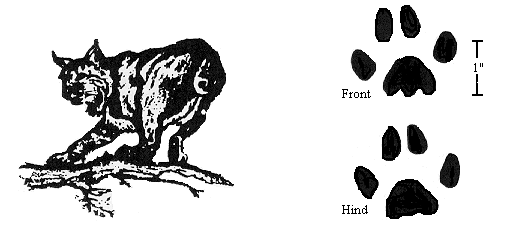

DISTRIBUTION: Abundant only in the counties adjoining the Little Missouri, Heart, Cannonball, and Missouri Rivers. Occasional along the Red River in eastern North Dakota and in the northern counties. Rare in the prairie pothole region of North Dakota.
HABITAT: Bobcats prefer rough country and dense timber or brush. They are somewhat shy and are not normally abundant in the vicinity of thickly populated areas.
LIFE HISTORY: Bobcats breed in February or March and the two to four young are born about 63 days later. The young bobcats stay in their nests, usually a cave or hole in the rocks or a side hill, for about two months. They remain with their parents through the winter.
Bobcats weigh from eleven to thirty pounds with occasional larger specimens weighing even more. They are most active at night and spend much of their time during the day in sleeping. They do not hibernate but are active all winter.
FOOD HABITS: Rabbits, ground squirrels, chipmunks, and mice make up the bulk of the bobcats' diet. They also eat birds, carrion, and poultry and occasionally take young livestock and deer if available.
SUGGESTED BAIT: Bobcat gland lures, or fresh meat scraps like the coyote, the bobcat follows definite routes of travel when making its rounds and will travel the same trail each time it is in the area. If you can determine where these routes are, you can catch bobcats in trail or blind sets. Good spots for such a set can be found where a trail is narrowed down by natural obstructions. By placing guide sticks across the path, you can increase the chances of having the bobcats step into your trap.
Visual attracters can be hung in a tree or brush and a trap concealed under it. Many bobcat trappers hang a piece of skin above a trap in such a way that the wind moves it around and draws the attention of the cat to the bait. Some trappers build roofed cubbies of sticks or other materials and use them year after year. These are especially useful in areas where deep snow will normally cover your bait and trap.
Bobcats are often caught in dirt hole sets made for foxes. The dirt hole set can be modified for trapping bobcats by substituting a catnip lure for the fox urine and liver.